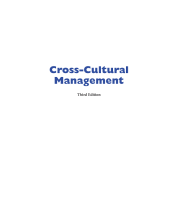Summary: Articles
- This + 400k other summaries
- A unique study and practice tool
- Never study anything twice again
- Get the grades you hope for
- 100% sure, 100% understanding
Read the summary and the most important questions on Articles
-
1 Articles
This is a preview. There are 18 more flashcards available for chapter 1
Show more cards here -
Potential challenges for Digital marketing (Leeflang et al, 2014)
-Ability to generate and leverage deep customer insight
-Managing brand health and reputation in a social media environment
- Assessing the effectiveness of digital marketing
- (The increasing talent gap in analytical capabilities within a firm) -
Biggest improvement opportunities of dealing with these challenges (Leeflang et al, 2014)
-Filling talent gaps (supply and demand of analytically trained people in marketing)
-Adjusting the organizational design
-Implementing actionable metrics -
Impact of media revolution (Edelman & Salsberg 2010)
·Integration of different media
·New publishing models are evolving
·More personally relevant
·Real time conversation (social networks) -
Four priorities for marketing in organizations (Edelman & Salsberg, 2010)
·Think about strategically the role of each media type
·Rebalance time and resources
·Develop a clear community or social networking
·Improve both art and science of marketing (consumer experience) -
Path to purchase, 3 basic steps (Srinivasan, 2015)
- Learning > cognitive (click on ad)
- Feeling > affective (liking)
- Behavior > conative (purchase)
-
Results Taxonomy based approach (Anderl & Kunz, 2016)
- FIC > CIC: narrowing down choice and actively searching for new info; indicates increase in purchase propensity
- Generic > Branded CIC: inclusion of brand in consideration set; looking for more detailed info
- Branded > Generic CIC: identifying alternative brands; indicates a decrease in purchase probability
- FIC > CIC: narrowing down choice and actively searching for new info; indicates increase in purchase propensity
-
Helps retailers to determine (Anderl & Kunz, 2016)
-the content of ads (in retargeting strategies)
-the value of real-time bids (higher when a customer has prior clicks in FIC’s)
-individualized marketing or targeting strategies (info about shipping options for consumers who use CIC’s and already visited through FIC’s in the past; or offer special promotions to consumers who switched from branded to generic CIC’s) -
Customer journey map (Dell)
1.Define the exact area (e.g. product, service or task)
2.Create a persona based on the customer’s demographic and psychographic profile
3.Map this persona’s journey across a specific task and identify touchpoints with the organization -
4 types of measurement and attribution
- intra-channel
- online to offline
- cross channel
- cross device
-
Framework and guidelines for managing SM (peters et al., 2013)
- Motives
- Content
- Network structure
- Social roles & interactions
- Higher grades + faster learning
- Never study anything twice
- 100% sure, 100% understanding
































